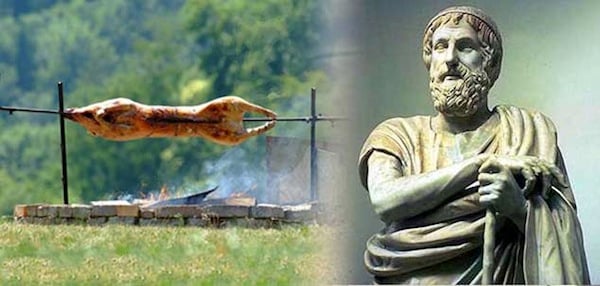
When Ancient Greeks roasted lamb on a spit, as there were no brushes or lemons then, they dipped a pine tree branch into juices of unripe grapes and plums and basted the meat, giving it a special fruit and resin flavor. For the preparation of kokoretsi, they marinated the lamb’s intestines in vinegar, water and honey. The vinegar functioned as an antiseptic and dehydrated most of the fat of the intestine, while the honey created a caramelized crust.
Today, Chef Nikos Fotiadis, prepares lamb and kokoretsi in the same way. However, instead of a pine tree branch, he uses pine needles to roast lamb and goat. “Kokoretsi is a dish recorded in the works of Homer, who reveals it was prepared in ancient Greece. In fact, the details concerning its preparation are particularly interesting,” he told AMNA, and stressed that the result impresses everyone who tastes kokoretsi he prepares with the same recipe. “The honey in the kokoretsi isn’t so obvious; however its presence during the roasting gives the meat an excellent texture to the final result,” he added. He also said that ancient Greeks didn’t use spits so much, as they didn’t consume large quantities of meat.
Nowadays, apart from the well-known spit, every region has its own Easter culinary traditions which include many different versions- from the Macedonian recipe of kleftiko (literally meaning of the thief), which is slow-roasted bone lamb, and the rifi (goat) with patouda of Naxos, to the hotpot lamb of Epirus and the Cretan gardoumia (animal entrails in lemon sauce).
On the Greek islands, in most cases, lamb is stuffed with various herbs and rice and is roasted in the oven. The rifi with patouda of Naxos is lamb with chards and poppies that grow at Easter, fennel, myronia (winter herbs) and fresh onions. In the north, in Mytilene, according to tradition, the lamb is stuffed with rice, without herbs, but with pine nuts, raisins and bowels.
In Epirus the meat is cooked in a hotpot, accompanied with local mountain herbs and when cooked, egg and lemon sauce are added. In Patras, the lamb is traditionally roasted with bellies and legs, while in Mani the so called regali, is a meat dish with tomato, with a little broth and tomato sauce.
In Crete the traditional gardoumia is prepared in any three different ways: either with the leg of the lamb wrapped with intestine, with liver, or with the intestine and the intestine slip.
See all the latest news from Greece and the world at Greekreporter.com. Contact our newsroom to report an update or send your story, photos and videos. Follow GR on Google News and subscribe here to our daily email!



